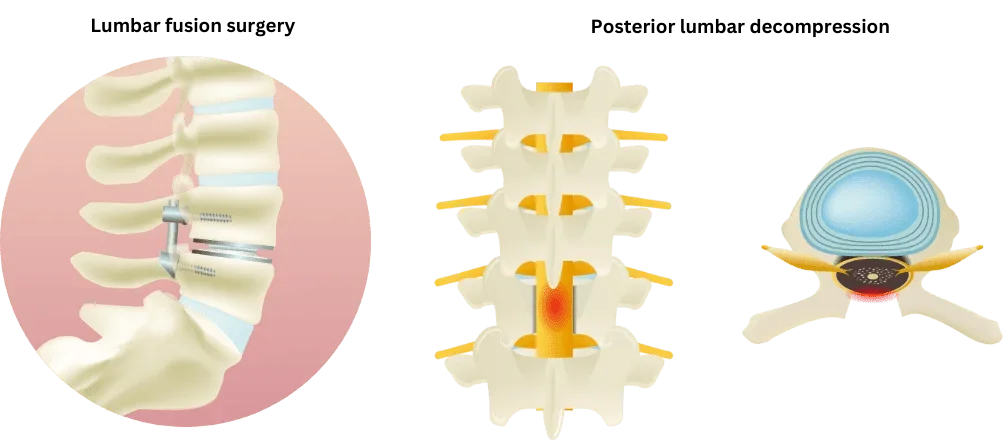Column The Cost of a Spondylolisthesis Surgery: Full Disclosure of the Market Prices for Each Surgical Procedure, and Whether They are Covered by Health Insurance.
August 10, 2023
Sometimes, abnormalities in the joints of the spine called intervertebral joints or intervertebral discs can cause the bones to slip out of alignment. This is a condition known as spondylolisthesis.
Lumbar spondylolisthesis is most common in the fourth lumbar vertebra, followed by the fifth and third lumbar vertebra. The cause is age-related functional deterioration of the intervertebral discs and intervertebral joints, resulting in a higher incidence as age advances.
Spondylolisthesis are accompanied by symptoms such as back pain, pain and numbness in the buttocks and lower extremities. Intermittent claudication is also common, with numbness and pain in the buttocks and thighs that appears while walking, and after a short break, the patient is able to walk again.
This is what spondylolisthesis is, but you may also be concerned about what treatments are availble for that particular condition.
In today’s article, we will discuss surgery for lumbar spondylolisthesis and its associated costs.
Advantages and disadvantages of health insurance vs out-of-pocket treatment
Depending on the medical institution chosen, surgery can either be covered by health insurance or as an out-of-pocket medical cost.
Treatment covered by health insurance
Patients with health insurance typically only have to bear 10 to 30% of the treatment costs.
However, in many of the cases when health insurance is involved, some restrictions apply on necessary examinations such as MRI, the required waiting time until surgery, and the equipment and medical equipment that can be used during the surgery.
Out-of-pocket treatment
In out-of-pocket treatment, the patient bears the full cost of the treatment (100%). Although cost is a major downside, the advantages of out-of-pocket treatment are far from negligible, as the time between the MRI and the actual surgery is much shorter, it allows the use of a wider range of equipment and provides a more minimally invasive procedure. Depending on the treatment, out-of-pocket treatment may also not need any hospitalization time and the postoperative rest period may also be shortened.
Surgery for spondylolisthesis and its associated costs
Generally, the first step in the treatment of spondylolisthesis is conservative therapy. If symptoms do not improve with conservative treatment and tend to persist, surgery is considered next.
The most common surgical procedures are lumbar fusion and posterior lumbar decompression.

* The cost of surgery varies depending on the disc level to be treated and the medical institution chosen, but the following is a summary of the cost of surgery per level as performed at main medical institutions in Japan.
* In the case of a surgery requiring hospitalization, the expenses (basic hospitalization fee, meals, etc.) will be charged in addition to the treatment cost, which may amount to more than 1 million yen in total.
Lumbar fusion surgery
During fusion surgery, the part of the spine that is compressing the nerves is removed, and bone is then grafted to secure the spine in place.
A 4.5 cm incision is made in the back, the intervertebral joint on the symptomatic side is removed, the disc is removed, the patient’s own bone or bone from a bone bank is grafted to it, and it is subsequently fused to the upper and lower vertebrae with internal fixation devices (screws and rods).
By fixing the slipped lumbar vertebrae, the unstable spine can be stabilized and further slippage can be prevented.
Treatment covered by health insurance.
Length of hospitalization: approximately 2 weeks.
Rest period: for 3 months after surgery.
Cost: 600,000-850,000 yen (30% of the total cost).
Posterior lumbar decompression
An incision of approximately 3 cm is made in the lumbar region under general anesthesia, and the spinal canal is then widened by removing the vertebral arches under fluoroscopy.
It may be performed alone or in combination with fusion surgery for spondylolisthesis.
Decompression surgery is used to improve the symptoms when the bone has slipped and compresses the nerve. When combined with fusion, it can also be used to stabilize the spine.
Treatment covered by health insurance.
Approximately one week (for decompression surgery alone).
Cost: 250,000-400,000 yen (30% of the total cost) (for decompression surgery alone).
Our treatment to repair the intervertebral disc – the Cellgel method
Our clinic offers the Cellgel method as a treatment for spondylolisthesis.
According to recent studies, disc degeneration is one of the causes of spondylolisthesis. *1
That is why it is our belief that prevention of spondylolisthesis cannot be achieved without first repairing the degenerated intervertebral discs.
*1 Reference: I. Akkawi, H. Zmerly. Degenerative Spondylolisthesis: A Narrative Review. Acta Biomedica, vol. 92, No.6, 2021.
We inject a gel-like agent into the degenerated disc to repair the disc. The volume of the disc is not reduced but preserved, preventing the spine from progressing into the misalignment that causes the spondylolisthesis.
Unlike conventional surgery, this treatment does not involve incisions, so there are fewer postoperative risks.
The hospital stay is only half a day, and you can go home on the same day of treatment.
The Cellgel procedure is an out-of-pocket treatment, and costs 1,420,000 yen (100% of the total cost) for a single disc level.
If you suffer from sciatica or have ever been diagnosed with a herniated disc or spinal stenosis, please consider having a consultation at our clinic.



